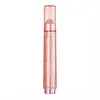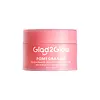What's inside
What's inside
 Key Ingredients
Key Ingredients

 Benefits
Benefits

 Concerns
Concerns

 Ingredients Side-by-side
Ingredients Side-by-side

Water
Skin ConditioningGlycerin
HumectantDicaprylyl Ether
EmollientIsononyl Isononanoate
EmollientButylene Glycol
HumectantDipropylene Glycol
HumectantC9-12 Alkane
SolventPEG-30 Dipolyhydroxystearate
EmulsifyingPolyglyceryl-4 Oleate
EmulsifyingMagnesium Sulfate
Niacinamide
Smoothing1,2-Hexanediol
Skin ConditioningPolyglyceryl-3 Polyricinoleate
EmulsifyingMilk Protein Extract
Parfum
MaskingCaprylyl Glycol
EmollientChlorella Vulgaris Extract
Skin ConditioningGlucose
HumectantFructooligosaccharides
HumectantFructose
HumectantCaprylic/Capric Triglyceride
MaskingAdenosine
Skin ConditioningHydrogenated Lecithin
EmulsifyingSoluble Proteoglycan
Skin ConditioningEthylhexylglycerin
Skin ConditioningBenzyl Salicylate
PerfumingLimonene
PerfumingCeramide NP
Skin ConditioningHydroxypropyltrimonium Hyaluronate
Linalool
PerfumingHexyl Cinnamal
PerfumingHydroxycitronellal
PerfumingTocopherol
AntioxidantAlpha-Isomethyl Ionone
PerfumingBeta-Glucan
Skin ConditioningGeraniol
PerfumingHydrolyzed Elastin
EmollientHydrolyzed Collagen
EmollientHexapeptide-2
BleachingBiotin
AntiseborrhoeicSodium Dna
Skin ConditioningWater, Glycerin, Dicaprylyl Ether, Isononyl Isononanoate, Butylene Glycol, Dipropylene Glycol, C9-12 Alkane, PEG-30 Dipolyhydroxystearate, Polyglyceryl-4 Oleate, Magnesium Sulfate, Niacinamide, 1,2-Hexanediol, Polyglyceryl-3 Polyricinoleate, Milk Protein Extract, Parfum, Caprylyl Glycol, Chlorella Vulgaris Extract, Glucose, Fructooligosaccharides, Fructose, Caprylic/Capric Triglyceride, Adenosine, Hydrogenated Lecithin, Soluble Proteoglycan, Ethylhexylglycerin, Benzyl Salicylate, Limonene, Ceramide NP, Hydroxypropyltrimonium Hyaluronate, Linalool, Hexyl Cinnamal, Hydroxycitronellal, Tocopherol, Alpha-Isomethyl Ionone, Beta-Glucan, Geraniol, Hydrolyzed Elastin, Hydrolyzed Collagen, Hexapeptide-2, Biotin, Sodium Dna
Water
Skin ConditioningGlycerin
HumectantNiacinamide
SmoothingButylene Glycol
HumectantCaprylic/Capric Triglyceride
MaskingPunica Granatum Fruit Extract
AntioxidantPropylene Glycol
HumectantAmmonium Acryloyldimethyltaurate/Vp Copolymer
Dimethicone
EmollientBetaine
HumectantGlycereth-26
HumectantIsopropyl Palmitate
Emollient1,2-Hexanediol
Skin ConditioningHydroxyacetophenone
AntioxidantCetearyl Alcohol
EmollientPolyacrylate-13
Allantoin
Skin ConditioningButyrospermum Parkii Butter
Skin ConditioningCentella Asiatica Extract
CleansingDimethyl Isosorbide
SolventPolyisobutene
Parfum
MaskingSodium Hyaluronate
HumectantXanthan Gum
EmulsifyingHydroxypinacolone Retinoate
Skin ConditioningPentylene Glycol
Skin ConditioningPolysorbate 20
EmulsifyingSorbitan Isostearate
EmulsifyingRosa Hybrid Flower Extract
Skin ConditioningNonapeptide-1
Skin ConditioningTetrapeptide-1
Skin ConditioningGardenia Florida Fruit Extract
Skin ConditioningCI 16185
Cosmetic ColorantWater, Glycerin, Niacinamide, Butylene Glycol, Caprylic/Capric Triglyceride, Punica Granatum Fruit Extract, Propylene Glycol, Ammonium Acryloyldimethyltaurate/Vp Copolymer, Dimethicone, Betaine, Glycereth-26, Isopropyl Palmitate, 1,2-Hexanediol, Hydroxyacetophenone, Cetearyl Alcohol, Polyacrylate-13, Allantoin, Butyrospermum Parkii Butter, Centella Asiatica Extract, Dimethyl Isosorbide, Polyisobutene, Parfum, Sodium Hyaluronate, Xanthan Gum, Hydroxypinacolone Retinoate, Pentylene Glycol, Polysorbate 20, Sorbitan Isostearate, Rosa Hybrid Flower Extract, Nonapeptide-1, Tetrapeptide-1, Gardenia Florida Fruit Extract, CI 16185
 Reviews
Reviews

Ingredients Explained
These ingredients are found in both products.
Ingredients higher up in an ingredient list are typically present in a larger amount.
1,2-Hexanediol is a synthetic liquid and another multi-functional powerhouse.
It is a:
- Humectant, drawing moisture into the skin
- Emollient, helping to soften skin
- Solvent, dispersing and stabilizing formulas
- Preservative booster, enhancing the antimicrobial activity of other preservatives
Butylene Glycol (or BG) is used within cosmetic products for a few different reasons:
Overall, Butylene Glycol is a safe and well-rounded ingredient that works well with other ingredients.
Though this ingredient works well with most skin types, some people with sensitive skin may experience a reaction such as allergic rashes, closed comedones, or itchiness.
Learn more about Butylene GlycolThis ingredient is an emollient, solvent, and texture enhancer. It is considered a skin-softener by helping the skin prevent moisture loss.
It helps thicken a product's formula and makes it easier to spread by dissolving clumping compounds.
Caprylic Triglyceride is made by combining glycerin with coconut oil, forming a clear liquid.
While there is an assumption Caprylic Triglyceride can clog pores due to it being derived from coconut oil, there is no research supporting this.
Learn more about Caprylic/Capric TriglycerideGlycerin is already naturally found in your skin. It helps moisturize and protect your skin.
A study from 2016 found glycerin to be more effective as a humectant than AHAs and hyaluronic acid.
As a humectant, it helps the skin stay hydrated by pulling moisture to your skin. The low molecular weight of glycerin allows it to pull moisture into the deeper layers of your skin.
Hydrated skin improves your skin barrier; Your skin barrier helps protect against irritants and bacteria.
Glycerin has also been found to have antimicrobial and antiviral properties. Due to these properties, glycerin is often used in wound and burn treatments.
In cosmetics, glycerin is usually derived from plants such as soybean or palm. However, it can also be sourced from animals, such as tallow or animal fat.
This ingredient is organic, colorless, odorless, and non-toxic.
Glycerin is the name for this ingredient in American English. British English uses Glycerol/Glycerine.
Learn more about GlycerinNiacinamide is a multitasking form of vitamin B3 that strengthens the skin barrier, reduces pores and dark spots, regulates oil, and improves signs of aging.
And the best part? It's gentle and well-tolerated by most skin types, including sensitive and reactive skin.
You might have heard of "niacin flush", or the reddening of skin that causes itchiness. Niacinamide has not been found to cause this.
In very rare cases, some individuals may not be able to tolerate niacinamide at all or experience an allergic reaction to it.
If you are experiencing flaking, irritation, and dryness with this ingredient, be sure to double check all your products as this ingredient can be found in all categories of skincare.
When incorporating niacinamide into your routine, look out for concentration amounts. Typically, 5% niacinamide provides benefits such as fading dark spots. However, if you have sensitive skin, it is better to begin with a smaller concentration.
When you apply niacinamide to your skin, your body converts it into nicotinamide adenine dinucleotide (NAD). NAD is an essential coenzyme that is already found in your cells as "fuel" and powers countless biological processes.
In your skin, NAD helps repair cell damage, produce new healthy cells, support collagen production, strengthen the skin barrier, and fight environmental stressors (like UV and pollution).
Our natural NAD levels start to decline with age, leading to slower skin repair, visible aging, and a weaker skin barrier. By providing your skin niacinamide, you're recharging your skin's NAD levels. This leads to stronger, healthier, and younger looking skin.
Another name for vitamin B3 is nicotinamide. This vitamin is water-soluble and our bodies don't store it. We obtain Vitamin B3 from either food or skincare. Meat, fish, wheat, yeast, and leafy greens contain vitamin B3.
The type of niacinamide used in skincare is synthetically created.
Learn more about NiacinamideParfum is a catch-all term for an ingredient or more that is used to give a scent to products.
Also called "fragrance", this ingredient can be a blend of hundreds of chemicals or plant oils. This means every product with "fragrance" or "parfum" in the ingredients list is a different mixture.
For instance, Habanolide is a proprietary trade name for a specific aroma chemical. When used as a fragrance ingredient in cosmetics, most aroma chemicals fall under the broad labeling category of “FRAGRANCE” or “PARFUM” according to EU and US regulations.
The term 'parfum' or 'fragrance' is not regulated in many countries. In many cases, it is up to the brand to define this term.
For instance, many brands choose to label themselves as "fragrance-free" because they are not using synthetic fragrances. However, their products may still contain ingredients such as essential oils that are considered a fragrance by INCI standards.
One example is Calendula flower extract. Calendula is an essential oil that still imparts a scent or 'fragrance'.
Depending on the blend, the ingredients in the mixture can cause allergies and sensitivities on the skin. Some ingredients that are known EU allergens include linalool and citronellol.
Parfum can also be used to mask or cover an unpleasant scent.
The bottom line is: not all fragrances/parfum/ingredients are created equally. If you are worried about fragrances, we recommend taking a closer look at an ingredient. And of course, we always recommend speaking with a professional.
Learn more about ParfumWater. It's the most common cosmetic ingredient of all. You'll usually see it at the top of ingredient lists, meaning that it makes up the largest part of the product.
So why is it so popular? Water most often acts as a solvent - this means that it helps dissolve other ingredients into the formulation.
You'll also recognize water as that liquid we all need to stay alive. If you see this, drink a glass of water. Stay hydrated!
Learn more about Water